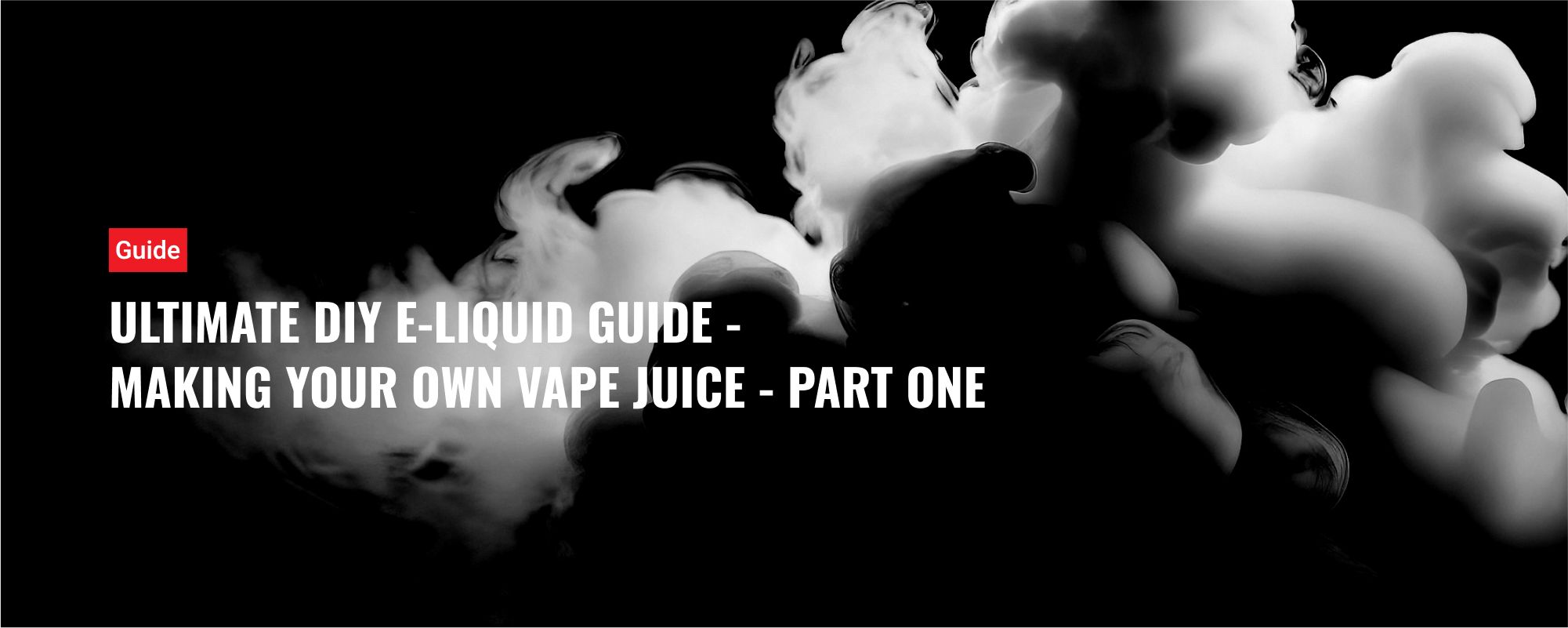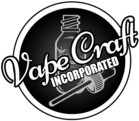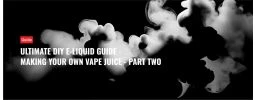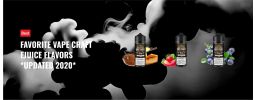

Why make your own DIY E-Juice?
Making your own e-liquid is, on its face, a daunting task. The sheer volume of different flavor bases available to you alone is intriguing and potentially overwhelming, but with a solid plan heading into things it's not only fairly easy, but extremely rewarding to make your own e-juice. There are several reasons to consider mixing your own e-juice, the most important of which we will outline here. Control: You're in the driver's seat now! You will have absolute control of your flavors, from the ability to remove any form of sweetener from your mixes (and by extension extending coil life) to the ability to create flavors you otherwise have had little to no luck finding elsewhere. For example, you lovethe idea of a fruity pebbles flavor, but you've had little luck with finding one that didn't taste as though it was one part fruity pebbles, and one part lemon pledge. If you're mixing your own juice: you can control that. Legislation: It is no secret that in the US we have seen government regulations at the local, state, and the federal level that could totally halt the ability to get your hands on your favorite flavors From states like Indiana's recently overturned play at making e-liquid vendors pass an all but impossible vetting by an approved security firm (there was only ever one firm that was approved), to localities like San Francisco's currently extant flavor ban limiting shops to carrying only tobacco and unflavored e-liquids, the precedent is set for more legislation in the future. By mixing your own juice you would be able to get out ahead of these types of laws. Saving Money: If there is one reason that people turn to making their own e-juice it is because of the ability to save money. Let's look at a simple breakdown of costs. A single 100ml bottle of Keep it 100's Strawberry Milk costs about $29.99, which would mean about 30 cents per ml of e-liquid. Vape Craft Inc's vegetable glycerin is $3.99 for 125ml, which is just over 3 cents per ml. Our nicotine base is $9.00 per 60 ml, or 15 cents per ml. With many flavors averaging about 5.25 dollars for a 30ml container (17.5 cents per ml) a simple recipe of 4mls of a strawberry flavoring and 4mls of a vanilla ice cream flavor against 6.25mls of nicotine base and 85.75 mls of vegetable glycerine would cost you, the e-juice creator $2.57 (VG cost) + $0.70 (strawberry cost) + $0.70 (cream cost) + $0.94 (nicotine cost for 3mg liquid) + $1.05 (bottle to store it in) for a grand total of $5.96. Each bottle of eliquid bought at the initial price costs over 5 times more than it would to mix your own. Extrapolate that out to the cost over a year. If you're vaping 20mls of juice per day it would cost you 6 dollars in e-juice at the "premium" price, or $2190 per year. For the above calculations you'd be spending $1.19 per day or $435.08 over the course of a full year. Just mixing your own e-juice and changing nothing else about your vaping habits would save you $1754.92 per year. There is no question that mixing your own juice is the far and away more economical choice.
So what do you need to get started?
Vegetable Glycerine - Vegetable Glycerine, sometimes listed as Glycerol , Glycerin or Glycerine is as the name implies a plant derived substance that is generally recognized as safe (GRAS) by the US FDA for inclusion in food products and is used in a myriad of ways from being used to keep food products moist, the creation of fog machine liquids to soaps, in hair gel, or in various pharmaceutical products. The product has a naturally sweet taste but no real flavor to speak of. VG is the thickest component of e-liquid, it is typically used to help smooth out the profile of the vapor and reduce harshness while also allowing for thicker, richer cloud production. Because VG is so viscous it's worth considering that many tanks and RTAs will not be able to keep up with a "Max" VG juice, including a bit of PG or a very small amount of distilled water to your juice thin enough to wick well is very important for use in many tanks, both the older and newer atomizers will fall victim to this at times. VG is Hydroscopic, which means that it will absorb water from the surrounding air. This is important to note as it will contribute to causing mild dehydration if one does not keep up with adequate liquid intake. It is important to note that not just any VG will do for use in your e-liquid. Some people are comfortable using food grade product but, whenever possible, USP or pharmaceutical grade VG is your very best bet. This ensures the greatest purity VG for use in your e-liquid. Propylene Glycol - Propylene Glycol or PG is used in a synthetic polymer that is, much like VG generally considered as safe. It is used in a myriad of varying markets, and is the part of e-liquid that is often referenced as being used as antifreeze. This much is factually correct, but not in the antifreeze you're thinking of. The green liquid used in your car is Ethylene Glycol, and is not safe for human consumption. Propylene Glycol on the other hand may be used in larger scale office buildings as antifreeze in the heating and cooling systems as it is much safer. PG does depress the freezing point of water, and for that reason it can also be used as a de-icing agent for airplanes, again being used because it is much safer for human or animal interaction or incidental ingestion. PG is an excellent solvent for flavors, and that is where it lies often in the food industry as well as ours. The vast majority of flavors produced that we use in our e-liquids are concentrated suspensions in PG. It is important to note that while VG is very smooth, PG does produce a mild "throat hit" and is often in modern e-liquid reduced to about 30% or less of the finished product to allow the liquid to remain smooth while still carrying a satisfying flavorful experience. Oftentimes users of tank style atomizers will prefer to keep their e-liquid at no less than 20% PG so as to allow for faster wicking, though for those of us who prefer to use drippers or squonking atomizers may wish to limit PG concentrations to the lowest volume possible for greater smoothness and larger or thicker clouds. Much like VG, PG can be purchased in a number of different graded qualities, and the same rules hold true: whenever possible USP grade PG is the absolute best option to use. Nicotine - Strictly speaking nicotine is not a necessary component in e-liquids, but for the many of us who are mixing with nicotine there are several variants of nicotine liquid that can be acquired. Nicotine can be suspended in VG, PG, or a mixture of the two. For those seeking a true "max VG" experience, the option is clear, but for anyone else it is worth looking into PG or 50/50 based nicotine as it will be easier to work with as the liquid remains thinner and the nicotine tends to remain better dispersed throughout the liquid. In any situation, shaking or otherwise agitating your concentrated nicotine prior to use is highly recommended to prevent "hot spots" of higher concentration nicotine being added to your final mixture. Nicotine is most often purchased at a markedly higher concentration than is practical for use directly as is. With modern Sub-ohm atomizers it is often advised to use 6mg or lower nicotine liquids, though some do prefer or require a higher nicotine concentration. When one is working with concentrated nicotine it is important to use safety gear such as disposable nitrile or latex gloves to prevent incidental exposure to the concentrated suspension as it can be readily absorbed through the skin. You may be familiar with feeling "Nic sick", which is to say nausea or undesirable lightheadedness associated with having too much nicotine in your system. That same experience is very much a real concern when working with concentrated nicotine. It is important also to note that storage for nicotine should always be done in a cool dark place. Ideally, in a freezer or refrigerator to prevent degradation or oxidation of your nicotine, as this will produce a progressively more "peppery" flavor in your final product. In any concentration, nicotine can always be reduced down for use in a given mixture. For example, in using 48mg/ml (that is 48 milligrams of nicotine per milliliter of the concentrated liquid) one can step the liquids concentration down to 3mg/ml by introducing 1.88ml of concentrated nicotine to 28.12mg of VG, PG, and flavorings to produce 30 ml of total e-liquid at a 3mg/ml concentration. If you are yet unsure of how much nicotine you should be using in your liquids, it is generally best to start low with 1.5-3mg of nicotine per milliliter of liquid, and adjust upwards as necessary to satisfy your nicotine cravings. Freebase nicotine, which is most commonly used for e-liquid is absorbed slowly by the body, and metabolized slowly as well, which means that you may not feel as immediately satisfied as you would have with a cigarette or other tobacco products. There is however a solution to this problem: Nicotine Salts. Using nicotine salts in your e-liquid is no different than using traditional freebase nicotine, but it is absorbed much faster by the body, allowing a more traditional spike in nicotine concentration in the body. Many consider nicotine salts to also feel smoother in use, which allows for higher concentrations in a mixture without producing harshness. For people transitioning from tobacco products nicotine salts may be a more satisfying experience. Nic salts are not without their downfalls however. The salts are much more readily absorbed by the body, but they are also much more quickly metabolized, which may mean more frequent vaping to maintain a satisfying amount of nicotine in the body at any point in time. Flavorings - There are a huge number of different flavorings available on the market. That is both extremely exciting for those of us who wish to experiment with flavor profiles and somewhat daunting for new mixers. It is important to note that not all flavor concentrates are created equal, Capella's Sweet Strawberry for example, does not taste the same as Flavor West's Strawberry or The Flavor Apprentice's Strawberry Ripe. All of these different flavors can be mixed together at times to produce a finished product that is much better rounded than the individual flavors, whether one is aiming for a more natural or a more candied flavor. Just as each flavor can be different, so too are the different manufacturers different. TFA or The Flavor Apprentice is often some of the most affordable flavoring on the market, and that doesn't mean that it's in any way worse than other brands, but it does often mean that the concentrates are just a bit weaker than others, and you'll need to use a bit more to accomplish the same intensity of flavor in your final mixture. Conversely Inawera flavors are often markedly more expensive, but can be used in very low concentrations to reach the same saturation of flavor. The flavors you use in e-liquids are your greatest point of control in creating your finished product. For those concerned with diketones (specifically Diacetyl) content in their juices, they can be avoided entirely by picking flavors that do not contain them. To avoid diacetyl in your DIY e-liquid it is best to check the manufacturer's website for ingredient lists. Most manufacturers will have both a V1 and a V2 of the same flavor. In those instances the second version is typically the recipe that does not contain diketones. Miscellaneous supplies - You will of course need other supplies, some of which cannot be avoided, and others are a matter of which path you take. Gloves - whether latex, nitrile, or vinyl you absolutely should be wearing gloves at all times when you're mixing juice. Nicotine can be absorbed through the skin, and in high concentrations can make you sick from nothing more than contact with your skin. Goggles - Just like the gloves, you should be wearing eye protection to avoid any accidental spills that could land irritants or nicotine in your eyes. Safety Apron - More of the same, you don't want to spill concentrates on your clothing, and you don't want to end up absorbing nicotine through your clothes. Pipettes - A great way to extract your juice or nicotine from the larger containers to place into your measurement vessel. These are typically disposable and very cheap to acquire in bulk. Treat them as single use items. Oftentimes they hold 3mls of liquid and have notches up the neck at ¼ ml increments up the neck. Syringes - The reusable option version of pipettes. Keeping your costs down long term, they're the better option, but they do require washing between uses, so they can be a fair bit more upkeep. Bottles - You can go with glass, LDPE, or PET plastics, and all have their ups and downs Glass, especially amber or otherwise tinted glass will be the best for long term storage, PET is a relatively stiff plastic, but the higher density makes it a great middle ground between glass and LDPE, which is nice and soft, a great option for use in daily carry unicorn bottles, but not necessarily great for long term storage as some flavor volatiles will be lost through the plastic. Measurement equipment - You can go with beakers or a graduated cylinder to measure your liquid through volume. This is a great option, and many people continue to use this form of measurement equipment. However, the reduced clean up and generally faster nature of mixing by weight with a scale cannot really be overstated. Any scale you use does need to read in grams and needs to read to the 1/100th of a gram (two decimal places). One of the most commonly recommended options is the AWS LB-501 Label maker - An absolutely optional tool, but in one way or another you're likely to want to have your bottles labeled and a simple dymo printer is a great readable option.
Understanding recipes
There are really two major notations to consider, typically you'll see a recipe written in a pure percentage format, as this is a pretty common standard and makes your recipes very easily scalable. You may however also see the weight or volumetric measurements listed for a specific sized bottle of juice. This isn't really harder to scale, typically just simple multiplication or division. Plenty of people have recorded recipes on various websites such as http://e-liquid-recipes.com/ or https://alltheflavors.com/ E-liquid-recipes displays a recorded recipe as such: About as much information as you could want all in one spot. The ml measurement and the weight for a set volume of juice (in the above image 30mls). It also displays percentages for each component. Alltheflavors displays percentages only, but does include tools for mixing a flavor. There are also myriad tools available across the internet and many apps for mobile devices. One great "catch all" app is the android app Vape Tool. Having a coil building tool, Ohm's law calculator, and e-juice blender all in one spot it's a great one-stop shop option. With mixing your juice, it's important to keep in mind what your VG and PG ratio will be at the end of your mix, using 10% flavoring which is suspended in PG and will reduce the amount of PG you want to use to dilute your juice in the end if you're aiming for a specific ratio. In the above recipe Fizzmustard uses 3mls of PG against 21 mls of VG in his initial mix because another 6 mls of flavoring and PG based nicotine will reduce the total recipe to a 70/30 ratio. Keeping in mind what you want your final measurements to be must factor in all of the components. Similarly, using different strengths of nicotine can increase or decrease the amount used in a mix, and as such how it impacts the final mixture. If you're using PG based nicotine you do need to keep the amount of nicotine added to the mix insofar as how it will impact your final mixture's VG/PG ratio. If you're using VG based nicotine, you are still altering the resultant mix, but oftentimes VG will be the last thing you add to a mix, so "mix to fill" can be an acceptable form of measurement there. VG based nicotine is, as mentioned earlier, thicker than PG based nicotine and is more prone to "hot spots", you always want to make sure you've shaken your nicotine base before adding it to a mix to avoid the nicotine settling into areas of higher concentration often referred to as "hot spots". As I mentioned before, oftentimes you'll see juices noted in percentages, and that's an absolute boon for the sake of scaling a recipe. 10% is 10% regardless of the volume being measured, so if you're looking to add 10% PG to your final mix to get to the desired ratio it's just a function of dividing your resultant volume by 10 and you've got your volumetric measurement for your PG to your final mixture.
How to actually mix the juice
There are two methodologies here, whether using a scale or a graduated cylinder you've got a few steps ahead of you to get your juice mixed up. The order in which you add components is not crucial, but it is often recommended that you begin with adding your nicotine if you'll be adding any so that if a mistake is to occur, you can correct it without tossing an entire bottle of extremely over-nic'ed juice or having to repeat steps to try to get your ratios to balance back out. Upon completing the mixing steps outlined here, you'll have juice that is ready to vape, or perhaps ready to set aside to steep. Volumetric measuring - For this you'll need a graduated cylinder and either pipettes or syringes. Beginning with your recipe you'll want to get your ingredients out and handy, if you've got a nice big table set everything you need out to one side and work through the list of ingredients one after the next. If you're working from a pre-calculated recipe you just need to add the correct volume to the graduated cylinder one after the next to make sure you're measuring the right amount of each component. Starting with Nicotine, then flavors, then PG, and finally VG seems the most logical progression. If you're working purely from percentages it's best to get all of your math done in advance, so you can confidently add your components one after the next rather than leaving the mixing station to grab a calculator between steps. So, as an example: say you're making the mustard milk recipe listed above. You would draw 1.8mls of your nicotine solution into a clean pipette or syringe, add it to the graduated cylinder and double check that your volume was correct. Repeating that process with the 1.8mls of TPA/TFA Strawberry, the 2.4 mls of TPA/TFA Vanilla bean ice cream, then using the same tools adding 3 mls of PG before filling to 30 mls of liquid with VG. Once you've completed your mix in the graduated cylinder, you can use a tool to agitate your mix like a small electric mixer, or you can move it to a bottle for storage, whether that's a unicorn bottle for immediate use or a bottle for longer term storage and proceed to seal the bottle and shake the mix to make sure it is all well integrated. From here, you now have a number of items to wash or dispose of. Continue wearing your gloves while washing or handling any devices that have been in direct contact with concentrated nicotine. Gravimetric measuring - Measuring by weight isn't any more complex than volumetric measurement. You'll need a scale, which is more expensive up front than the bare bones volumetric equipment but the steps are largely the same, though at times there may be a bit more math, or at the very least the math isn't quite as pretty. In most cases, it's as simple as setting the bottle you intend to house your final mixture right on the deck of your scale, turning it on and zeroing the scale. From there adding your components one after the next. Again using the above recipe as a reference point: once you have your scale reading 0.00g add 1.86g of nicotine solution to your bottle, whether through a pipette, the drip cap on your nicotine bottle, or a syringe. Next hit the "tare" button on your scale to return your display to 0.00g, and repeat the process with 1.80g of TFA strawberry, 2.40g of TFA Vanilla bean ice cream, and 3.00g of PG, then filling the bottle with VG to finish. Now you must cap the bottle and shake away to fully integrate your mixture. At this point you may have pipettes to dispose of, syringes to wash, or if nothing else a pair of gloves to throw away. Both options are simpler than they may seem up front, and the actual mixing of your juice may provide the lowest actual hurdle to your DIY experience.
So, about steeping
There are a few different reasons that one would want to steep their juice. Plenty of flavors will change over time as they mix and settle into a juice. Some mixes are nearly unvapeable when first mixed but will round into something truly delicious with a bit of time. Some reasons to steep your juice:
- Some flavors will bind together
- Some flavors contain alcohols and are initially harsher or have a chemical aftertaste that will dissipate as the juice steeps
- The juice will mix more fully and no longer require shaking as the molecules bind to one another to form a stable mixture
There are a number of different ways to steep juice, with varying levels of efficacy. Breathing - This method works best and may be most important with glass bottles as they don't allow the liquid to release much in the way of gasses. In this case after agitating the juice you would want to remove the cap of the bottle to allow the liquid to come into contact with fresh air. This has two functions. One being that you're introducing oxygen to the mixture and allowing the nicotine to oxidize slightly, the other being that you're allowing alcohols and some of the lighter flavor molecules evaporate out of the container. This helps steep a liquid, but in and of itself isn't the whole process.
Continue reading in the second part of the post.






